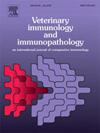Effect of infectious bursal disease virus infection on the expression of immune checkpoint molecules in SPF chickens
IF 1.4
3区 农林科学
Q4 IMMUNOLOGY
引用次数: 0
Abstract
Infectious bursal disease (IBD) is an acute, highly contagious, and immunosuppressive avian disease caused by infectious bursal disease virus (IBDV). Immune checkpoint molecules are vital for regulating immune equilibrium, preventing autoimmune responses, and controlling the scale and duration of immune reactions. These molecules are implicated in the immunosuppressive mechanisms initiated by viral infections. Currently, the correlation between IBDV infection and the expression of immune checkpoint molecules is not clearly defined. In this study, White Leghorn SPF chickens were inoculated with very virulent (vvIBDV), attenuated (attIBDV), or novel variant (nvIBDV) IBDV strains. Using real-time PCR, we quantified immune checkpoint genes and cytokines in the bursa of fabricius (BF), thymus, spleen, and peripheral blood mononuclear cells (PBMCs). The findings revealed a significant upregulation of immune checkpoint genes (PD-1, PD-L1, PD-L2, LAG3, CTLA4) in the BF, thymus, spleen, and PBMCs following infection with various virulent strains of IBDV compared to control tissues. Specifically, PD-L1 in BF surged to 7.32-fold (vvIBDV, 3 dpi), 7.44-fold (attIBDV, 3 dpi), and 6.47-fold (nvIBDV, 3 dpi) compared to controls. PD-L2 in spleen surged to 7.66-fold (attIBDV, 21 dpi), and 7.82-fold (nvIBDV, 21 dpi) compared to controls. Moreover, the expression levels of inhibitory and pro-inflammatory cytokines (TGF-β2, IL-10, IL-6, IL-1β, TNF-α) were notably elevated in infected tissues compared to control tissues, with IL-1β upregulated by 7.47-fold in BF at 3 dpi. TGF-β2 in spleen surged to 8.16-fold (vvIBDV, 21 dpi), 6.33-fold (attIBDV, 21 dpi), and 7.61-fold (nvIBDV, 21 dpi). These results suggest that IBDV infection in SPF chickens induces robust upregulation of immune checkpoint molecules (PD-1, PD-L1, PD-L2, LAG3, CTLA4) and cytokines (TGF-β2, IL-10, IL-6, IL-1β, TNF-α), correlating with viral virulence and immunosuppression. Our findings suggest that immune checkpoint dysregulation may contribute to IBDV pathogenesis, particularly in mediating sustained immunosuppression in poultry.
传染性法氏囊病病毒感染对SPF鸡免疫检查点分子表达的影响
传染性法氏囊病(IBD)是由传染性法氏囊病病毒(IBDV)引起的一种急性、高度传染性、免疫抑制的禽类疾病。免疫检查点分子对于调节免疫平衡、预防自身免疫反应、控制免疫反应的规模和持续时间至关重要。这些分子与病毒感染引发的免疫抑制机制有关。目前,IBDV感染与免疫检查点分子表达之间的关系尚不明确。在这项研究中,白来角SPF鸡分别接种了强毒(vvIBDV)、弱毒(attIBDV)和新型(nvIBDV) IBDV菌株。利用实时荧光定量PCR,我们定量了法氏囊(BF)、胸腺、脾脏和外周血单个核细胞(PBMCs)中的免疫检查点基因和细胞因子。研究结果显示,与对照组织相比,感染各种IBDV毒株后,BF、胸腺、脾脏和PBMCs中的免疫检查点基因(PD-1、PD-L1、PD-L2、LAG3、CTLA4)显著上调。具体而言,与对照组相比,BF中的PD-L1激增至7.32倍(vvIBDV, 3 dpi), 7.44倍(attIBDV, 3 dpi)和6.47倍(nvIBDV, 3 dpi)。与对照组相比,脾脏PD-L2激增至7.66倍(attIBDV, 21 dpi)和7.82倍(nvIBDV, 21 dpi)。此外,与对照组相比,感染组织中抑制和促炎细胞因子(TGF-β2、IL-10、IL-6、IL-1β、TNF-α)的表达水平显著升高,其中IL-1β在3 dpi时上调7.47倍。脾脏中TGF-β2分别为8.16倍(vvIBDV, 21 dpi)、6.33倍(attIBDV, 21 dpi)、7.61倍(nvIBDV, 21 dpi)。这些结果表明,IBDV感染SPF鸡可诱导免疫检查点分子(PD-1、PD-L1、PD-L2、LAG3、CTLA4)和细胞因子(TGF-β2、IL-10、IL-6、IL-1β、TNF-α)的显著上调,与病毒毒力和免疫抑制有关。我们的研究结果表明,免疫检查点失调可能有助于IBDV的发病机制,特别是在家禽中介导持续的免疫抑制。
本文章由计算机程序翻译,如有差异,请以英文原文为准。
求助全文
约1分钟内获得全文
求助全文
来源期刊
CiteScore
3.40
自引率
5.60%
发文量
79
审稿时长
70 days
期刊介绍:
The journal reports basic, comparative and clinical immunology as they pertain to the animal species designated here: livestock, poultry, and fish species that are major food animals and companion animals such as cats, dogs, horses and camels, and wildlife species that act as reservoirs for food, companion or human infectious diseases, or as models for human disease.
Rodent models of infectious diseases that are of importance in the animal species indicated above,when the disease requires a level of containment that is not readily available for larger animal experimentation (ABSL3), will be considered. Papers on rabbits, lizards, guinea pigs, badgers, armadillos, elephants, antelope, and buffalo will be reviewed if the research advances our fundamental understanding of immunology, or if they act as a reservoir of infectious disease for the primary animal species designated above, or for humans. Manuscripts employing other species will be reviewed if justified as fitting into the categories above.
The following topics are appropriate: biology of cells and mechanisms of the immune system, immunochemistry, immunodeficiencies, immunodiagnosis, immunogenetics, immunopathology, immunology of infectious disease and tumors, immunoprophylaxis including vaccine development and delivery, immunological aspects of pregnancy including passive immunity, autoimmuity, neuroimmunology, and transplanatation immunology. Manuscripts that describe new genes and development of tools such as monoclonal antibodies are also of interest when part of a larger biological study. Studies employing extracts or constituents (plant extracts, feed additives or microbiome) must be sufficiently defined to be reproduced in other laboratories and also provide evidence for possible mechanisms and not simply show an effect on the immune system.

 求助内容:
求助内容: 应助结果提醒方式:
应助结果提醒方式:


